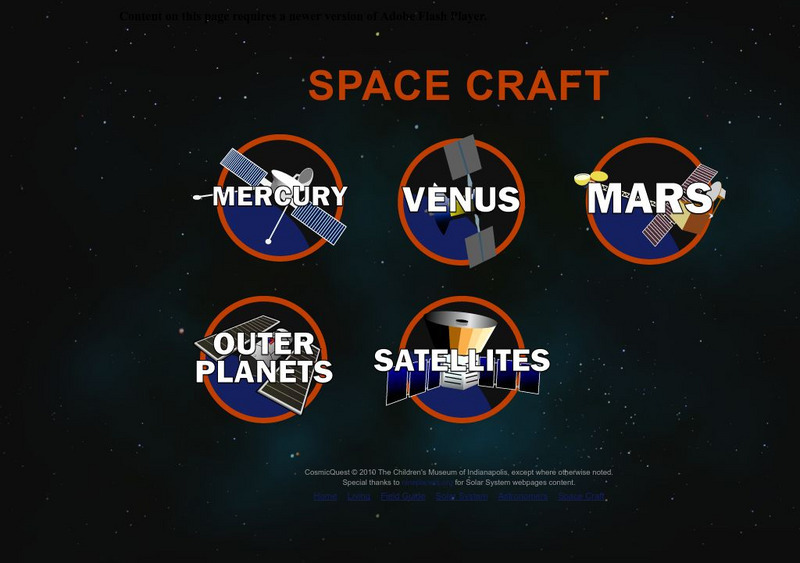Laboratory for Atmospheric and Space Physics
Looking to the Future
New Horizons set forth on a mission to Pluto in 2006. Ten years later, the spacecraft is still on its way. Here, enthusiastic scholars predict what they will be like—likes, dislikes, hobbies, etc.—when New Horizons arrives at its...
It's About Time
Competition Among Organisms
Who knew plants could be so competitive? Join your class as they observe plants competing for space and nutrients. Middle and high schoolers describe possible effects of introducing a new species into an already established...
Cheetah Outreach
Habitats
Explore six different habitats—wetlands, rainforest, savannah, desert, city, and cultivated land—to determine which habitat factors (food, water, shelter, and space) are high, medium, or low in each. Learners also use maps of Africa...
Laboratory for Atmospheric and Space Physics
Charting the Progress of New Horizons
In 2006, New Horizons began its mission to fly to Pluto. As it continues its journey, scholars track its progress with the help of an informative website, all the while reinforcing measurement concepts with the construction of a scaled...
Jefferson Township Schools
Major Greek Gods and Goddesses
From Poseidon (Neptune) to Aries (Mars) and Apollo, learners are given a great overview of the major Greek gods and goddesses with this resource, which includes a graphic organizer and reading excerpts on each of the gods.
Weebly
Ancient China
From China's physical geography and earliest beginnings of civilization to the Qin and Han dynasties, here is a nicely designed worksheet on ancient China, which includes a graphic organizer and timeline to summarize the reading...
McGraw Hill
Adding and Subtracting Radicals
Help remove some of the confusion surrounding the addition and subtraction of radical numbers with this set skills practice problems. Taken straight from the pages of a math text book, this resource provides learners with...
Curated OER
Our Solar System-- Fact File
In this space science worksheet, students read facts about the solar system. Students look at the diagram showing the position of the planets. Pluto is included as a planet here.
International Technology Education Association
Pixel This!
Did the image I drew match the image you saw? By simulating a satellite and a ground station, teams of two transmit data in the form of pixels in order to recreate an image. They use four different levels of brightness, creating slightly...
New Bedford Whaling Museum
A New Bedford Voyage!
A thorough set of activities, articles, and reference material can enlighten your class about the history of whaling in New England. Kids travel back to a time when whale products were valuable and hunting whales was a way to help the...
MENSA Education & Research Foundation
The Moon: Earth’s Dependable Neighbor
Scholars become experts on the moon, its phases, and craters with a series of lessons, activities, and extension opportunities. Learners' expert level of knowledge includes moon facts, how moon craters are created, the ability to...
Laboratory for Atmospheric and Space Physics
The Planets and Scale
Scholars gain an insight into the relative size of planets and distance between inner and outer planets with the help of informational text, a data table, and a series of four questions.
Smithsonian Institution
Visiting a Museum
Imperial storm troopers make a special guest appearance in this resource designed as a behavior primer for young visitors to a museum.
Michigan State University
May I Take Your Order?
If you're a pest, come and get a tasty meal here! Scholars work collaboratively to construct a mini restaurant out of a shoe box and create a menu that feeds a pest their favorite food.
San José State University
Prepositions of Direction
Practice using prepositions correctly in sentences. The first page describes how prepostions are used and what they mean. The second page gives scholars a chance to fill in a few sentences with prepositions.
Curated OER
Simple, Compound, Complex, and Compound-Complex Sentences
What kind of sentence is it? This can be a complex subject, so don't compound the difficulty by skipping over the topic! It's simple, just have your class read and go over the information here and then complete the included exercise.
Curated OER
The Earth
In this earth fact worksheet, students look at a picture of the planet earth and read a list of accompanying facts, along with a brief paragraph.
Curated OER
The Planet Venus
In this worksheet on the planet Venus, students look at a picture of the planet and read accompanying facts, along with a brief paragraph.
Smithsonian Institution
National Air and Space Museum: Exploring the Planets: Tools of Exploration
Part of the National Air and Space Museum's online exhibition about Exploring Planets, this describes and gives visuals of telescopes, probes and fly-by aircrafts, orbiters, and landers as current methods for earth and airborne...
Children's Museum
Field Guide to the Universe: Space Craft
Pictures and descriptions of the robot spacecraft that have explored the planets and outer space since the 1960s.
Digital History
Digital History: The Space Race
In October 1957, the Soviet Union launched Sputnik 1, the world's first artificial satellite. The 184-pound, 22.5-inch sphere orbited the earth once every 96 minutes. Sputnik transmitted radio signals for 21 days and later burned up in...
Smithsonian Institution
National Air and Space Museum: Exploring the Planets: Venus
Get the facts on Venus. Resource offers a variety of satellite images and facts about the structure and features of Venus.
Smithsonian Institution
National Air and Space Museum: Exploring the Planets: Mercury
This is a useful resource for facts and images pertaining to the planet Mercury.
Khan Academy
Khan Academy: The Start of the Space Race
Looks at the USSR's launch of Sputnik and the galvanizing effect it had on America's motivation to fund aerospace research. NASA was soon formed and more funding was put in place for public education in the sciences and math.

























